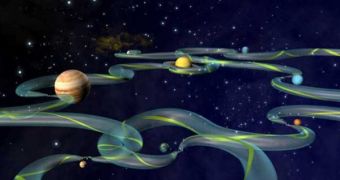Some science-fiction novels may have got it right. Space lanes, as envisioned in Edmond Hamilton's 1928 classic Crashing Suns, may indeed exist, and they may be connecting all the most important bodies in the solar system. These corridors are best described as low-speed, fuel-efficient pathways of traveling from one planet to another, for example, while making use of Lagrangian points. These are positions in an orbital configuration, where an object, such as a satellite, remains in the same relative position to a system.
For example, the Earth and the Moon for a system. In this system, there are five points that always remain in the same relative position in respect to the two bodies. This work, by Italian-French mathematician Joseph Louis Lagrange, is instrumental for allowing the launch of highly precise telescopes today. The European Space Agency's (ESA) Herschel and Planck are both on an orbit around the Sun, but remain in the same position relative to the star, Earth and the Moon at all times.
The new gravitational corridor idea holds that the most efficient method of traveling between two planets in the solar system is not necessarily the fastest. It may be, physicists reveal, that traveling between Lagrangian points surrounding various planets, asteroids and comets, is the most fuel-efficient way to go about space exploration. Admittedly, the lanes do not even provide high speeds, but a mission using them would not need to overcome the effects of gravity via its own power source.
The idea is not especially fit for sending probes to map Pluto, for example, as it would take many years for the spacecraft to reach its destination. It doesn't even have immediate applications. It may be useful when the moons of Jupiter or Saturn are inhabited, and people will need to travel from one to the other while consuming as little fuel as possible. But, admittedly, that scenario will not become a reality for the next thousand years, at least.
Another method of circumventing the long durations usually associated with space traveling would be the creation of a wormhole between two locations. Such an instrument would essentially bend the space-time continuum, allowing for instantaneous travel between two locations, however far from each other. Or we could just build really advanced rocket engines and warp drives, which apparently are not that far from reality as you might be tempted to think.

 14 DAY TRIAL //
14 DAY TRIAL //